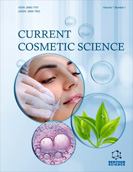Abstract
Background: Seed oils have been exploited for an array of purposes with their addition to dietary, cosmetics, or therapeutic products. The process of skin aging is a natural and complex phenomenon in living beings. Skin aging is classified into two independent processes, i.e., chronological aging and premature aging. Aging is observed as a loss of strength and elasticity of the skin, leading to wrinkles on the skin. It is due to a decrease in various components of the skin matrix, like elastin, collagen, and hyaluronic acid. Furthermore, aging is potentiated by excessive exposure to UV radiation (Photoaging) and can be prevented or reduced by using products that combat photoaging.
Objective: Anti-aging and antiwrinkle agents are in demand for maintaining skin tone. Seed oils composed of polyunsaturated fatty acids are traditionally used in cosmetic products as moisturizers and emollients, while palmitic acid and oleic acid are known for their penetration-enhancing effect. With the changing trend for extraction of oils like cold pressed methods, seed oils enriched with polyphenols, flavonoids, carotenoids, and phytosterols are good antioxidants and antimicrobials and therefore have an ever-growing demand for their usage in the treatment of skin diseases. In this review, an attempt will be made to brief the phytoconstituents present in various seed oils and their utilization against skin ailments. Furthermore, a mechanistic approach towards the benefit of oils in skin barrier repair, antiaging, and photo-aging with the help of extensive well-designed clinical trials carried out in the recent past is elaborated.
Methods: A literature search in the Scopus database, Pubmed, and Medline was carried out using the terminology “aging, photoaging, antioxidant, UV-protection, sunscreens, skin barrier repair, and fatty acids, formulations” in the study. Data were retrieved over the last twenty years.
Results: The review summarises the mechanistic approach and beneficial application of seed oils for healthy and glowing skin. The oils obtained from olives, sesame, borage, grape seeds, and carrot seeds have multitargeted effects. However, the variation in pharmacological effect may vary based on geographically differing varieties, skin type, and person-to-person variation. The need to standardize the varieties for their phytoactive ingredients and the composition of formulation used for skin care can help utilize the seeds as a potential source of actives against skin diseases.
Conclusion: The potential of seed oils can be increased with appropriate analytical tools, validation protocols, and systematic experimental studies at preclinical and clinical trials for their application to skin care products.
[http://dx.doi.org/10.22377/ijgp.v11i02.1031]
[http://dx.doi.org/10.3389/fphar.2019.00759] [PMID: 31354480]
[http://dx.doi.org/10.1001/archderm.138.11.1462] [PMID: 12437452]
[http://dx.doi.org/10.1016/j.jaad.2005.05.010] [PMID: 16781287]
[http://dx.doi.org/10.3390/antiox4020248] [PMID: 26783703]
[http://dx.doi.org/10.1016/j.jaad.2012.02.009] [PMID: 22406231]
[http://dx.doi.org/10.1117/1.JBO.17.8.085004] [PMID: 23224187]
[http://dx.doi.org/10.1016/j.bioorg.2017.12.030] [PMID: 29353733]
[http://dx.doi.org/10.3390/nu12030870] [PMID: 32213934]
[http://dx.doi.org/10.1111/1523-1747.ep12513042] [PMID: 778294]
[http://dx.doi.org/10.1046/j.1523-1747.2002.19636.x] [PMID: 12518793]
[http://dx.doi.org/10.1196/annals.1404.027] [PMID: 18056953]
[http://dx.doi.org/10.1016/j.mbplus.2020.100041] [PMID: 33543036]
[http://dx.doi.org/10.1002/path.2098] [PMID: 17200942]
[http://dx.doi.org/10.4161/derm.22804] [PMID: 23467476]
[http://dx.doi.org/10.1126/science.1355616] [PMID: 1355616]
[http://dx.doi.org/10.1016/S0753-3322(99)80087-0] [PMID: 10392290]
[http://dx.doi.org/10.2353/ajpath.2009.080599] [PMID: 19116368]
[http://dx.doi.org/10.1038/jidsymp.2009.8] [PMID: 19675548]
[http://dx.doi.org/10.1046/j.1523-1747.2003.12148.x] [PMID: 12713591]
[http://dx.doi.org/10.1038/379335a0] [PMID: 8552187]
[http://dx.doi.org/10.1046/j.0022-202x.2001.01544.x] [PMID: 11710936]
[http://dx.doi.org/10.1016/j.jdermsci.2010.10.010] [PMID: 21087840]
[http://dx.doi.org/10.1111/j.1748-1716.1988.tb08508.x] [PMID: 3227957]
[http://dx.doi.org/10.1016/j.lfs.2007.02.037] [PMID: 17408700]
[http://dx.doi.org/10.1016/S0070-2153(06)79005-6] [PMID: 17498549]
[http://dx.doi.org/10.1111/j.1467-2494.2004.213_6.x]
[http://dx.doi.org/10.1016/j.tifs.2019.11.015]
[http://dx.doi.org/10.4103/0378-6323.25776] [PMID: 16766830]
[http://dx.doi.org/10.1016/S0024-3205(99)00642-6] [PMID: 10680579]
[http://dx.doi.org/10.3390/ijms19010070] [PMID: 29280987]
[http://dx.doi.org/10.1590/1414-431x20188209] [PMID: 30785481]
[http://dx.doi.org/10.3390/molecules25040989]
[http://dx.doi.org/10.1590/s1984-82502016000300001]
[http://dx.doi.org/10.2478/hepo-2018-0026]
[http://dx.doi.org/10.1194/jlr.R700013-JLR200] [PMID: 17872588]
[http://dx.doi.org/10.1007/s10565-008-9087-5] [PMID: 18553143]
[http://dx.doi.org/10.1046/j.1365-4362.2001.01292.x] [PMID: 11737424]
[http://dx.doi.org/10.3346/jkms.2010.25.6.980] [PMID: 20514327]
[http://dx.doi.org/10.1111/j.0022-202X.2005.23682.x] [PMID: 15854043]
[http://dx.doi.org/10.1152/ajpendo.00035.2005] [PMID: 15914509]
[http://dx.doi.org/10.1055/s-2002-34411] [PMID: 12357383]
[http://dx.doi.org/10.1111/j.1365-2125.2012.04374.x] [PMID: 22765297]
[http://dx.doi.org/10.2174/138920106779116856] [PMID: 17168664]
[http://dx.doi.org/10.1194/jlr.M500420-JLR200] [PMID: 16467281]
[http://dx.doi.org/10.3945/jn.111.148080] [PMID: 22323763]
[http://dx.doi.org/10.3346/jkms.2010.25.6.930] [PMID: 20514317]
[http://dx.doi.org/10.1038/srep25616] [PMID: 27161953]
[http://dx.doi.org/10.1139/H10-076] [PMID: 21164549]
[http://dx.doi.org/10.1016/j.jdermsci.2011.12.005] [PMID: 22209282]
[http://dx.doi.org/10.1002/ptr.1363] [PMID: 14595575]
[http://dx.doi.org/10.1111/1523-1747.ep12541775] [PMID: 7373078]
[http://dx.doi.org/10.1194/jlr.R800039-JLR200] [PMID: 18980941]
[http://dx.doi.org/10.1016/0168-3659(95)00088-7]
[http://dx.doi.org/10.1111/j.1600-0781.2007.00298.x] [PMID: 17803593]
[http://dx.doi.org/10.1016/B978-1-893997-88-2.50008-0]
[http://dx.doi.org/10.1007/BF02523530]
[http://dx.doi.org/10.1111/ics.12520] [PMID: 30740755]
[http://dx.doi.org/10.1016/j.jff.2019.01.036]
[http://dx.doi.org/10.1093/carcin/21.11.2085] [PMID: 11062172]
[http://dx.doi.org/10.1590/S0104-66322012000200020]
[http://dx.doi.org/10.1016/j.bioorg.2013.06.009] [PMID: 23933354]
[http://dx.doi.org/10.3390/biom9090479] [PMID: 31547364]
[PMID: 16320859]
[http://dx.doi.org/10.1016/j.nut.2009.10.014] [PMID: 20579590]
[http://dx.doi.org/10.1111/j.1346-8138.2007.00391.x] [PMID: 18078406]
[http://dx.doi.org/10.1017/S0007114508020321] [PMID: 18761778]
[http://dx.doi.org/10.1002/ejlt.201900447]
[http://dx.doi.org/10.1016/j.foodchem.2008.06.005]
[http://dx.doi.org/10.1021/jf070440a] [PMID: 17567031]
[PMID: 8024628]
[http://dx.doi.org/10.1016/B978-0-12-818188-1.00053-0]
[http://dx.doi.org/10.2147/DDDT.S128470] [PMID: 28280300]
[http://dx.doi.org/10.1111/j.1600-0625.2008.00829.x] [PMID: 19320737]
[http://dx.doi.org/10.1080/09546634.2020.1721418] [PMID: 32022625]
[PMID: 18528589]
[http://dx.doi.org/10.1111/j.1600-0846.2011.00578.x] [PMID: 22092829]
[http://dx.doi.org/10.1021/jf802112c] [PMID: 18959412]
[http://dx.doi.org/10.5772/15308]
[http://dx.doi.org/10.1371/journal.pone.0232224] [PMID: 32343717]
[http://dx.doi.org/10.1080/09637480802549127]
[http://dx.doi.org/10.1159/000313516] [PMID: 20523108]
[http://dx.doi.org/10.1016/j.jtcme.2017.06.012] [PMID: 30671361]
[http://dx.doi.org/10.37358/RC.17.3.5489]
[http://dx.doi.org/10.29219/fnr.v62.1371] [PMID: 29720929]
[http://dx.doi.org/10.1021/jf8001679] [PMID: 18461963]
[http://dx.doi.org/10.1016/j.ctcp.2009.06.015] [PMID: 20129403]
[http://dx.doi.org/10.1111/j.1473-2165.2007.00293.x] [PMID: 17348990]
[http://dx.doi.org/10.1016/B978-0-12-818188-1.00030-X]
[http://dx.doi.org/10.1080/14764172.2018.1469769] [PMID: 29737890]
[http://dx.doi.org/10.3389/fphar.2020.00785] [PMID: 32547393]









